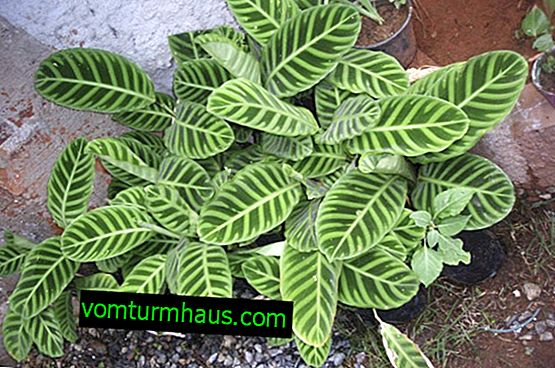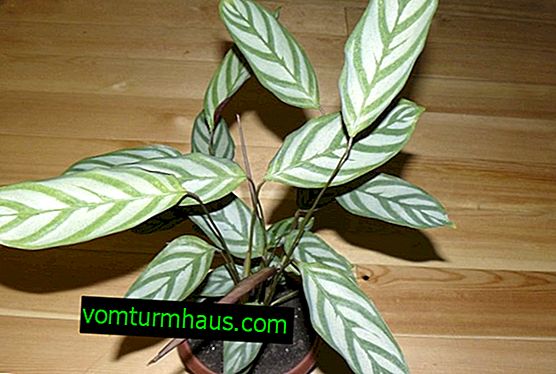How to care for the arrowroot at home
Maranta is a beautiful houseplant, not everyone can cope with growing it, because it is whimsical and instantly responds to mistakes when leaving. Below are tips on how to grow this demanding flower indoors.
Botanical description of the plant
Maranta is a perennial that has roots in the form of tubers, standing straight or creeping branches. He is considered to be of the same family and family. His homeland is Central and South America. Small bushes grow up to him - up to 30 cm tall. The real decoration of the arrowroot is its leaves. They are widely oval, 10–15 cm long and 5–9 cm wide. Depending on the species, they have different colors and patterns in the form of spots and stripes. The color of the lower and upper sides of the leaf is almost always very different from each other.
In spring and summer, the plant produces inflorescences with white or lilac small flowers. After flowering, fruits are formed in the form of seed boxes.

Did you know? The Indians made an antidote from the tuberous roots of the arrowroot, which healed the soldiers who were injured by poisoned arrows.
Varieties with photos and names
Arrowroot has many varieties. Among the most popular rooms 4:
- Tricolor or red stalk (tricolor). Its stem reaches a height of 20–25 cm. It has oval leaves of dark green color with pale edges, red veins and a yellowish pattern in the form of a feather on the upper plate and raspberry pink with pink veins on the bottom. It blooms in inflorescence in the form of an ear with lilac flowers. Flowering occurs in June.

Learn more about the features of growing tricolor arrowroot.
- Two-tone. This variety has oval leaves with wavy edges 15 cm long. They grow on short petioles. The upper part is green with brown spots. The lower one is reddish, covered with small hairs.

- White-faced. The plant has a drooping stem, reaching a length of 30 cm. Large leaves in the shape of a heart form on medium petioles in length. The upper leaf plate is painted in a bluish-green color with white veins. The bottom plate has a reddish tint.

- Reed. The flower can reach a height of up to 1.30 m. Its shoots are strong, erect. The leaves are elongated in the shape of an egg. They have pointed edges. The leaves are painted dark blue.

What conditions do you need to create at home
The homeland of the arrowroot is the tropics, which means that the favorable conditions for it are:
- heat;
- high humidity;
- good lighting.
Did you know? Maranto is popularly called a prayer plant. The fact is that in daylight its leaves are arranged horizontally, and in the evening they rise up. This ability is necessary for the flower to retain moisture, reducing evaporation, and to avoid sunburn.
Seat selection
The best place for growing arrowroot is a light windowsill, located in a light shade and sheltered from direct sunlight. Such conditions can be achieved by placing a container with a flower on the eastern or western window opening. It is allowed to grow from the south side, but not on the windowsill, but at a certain distance from it. The north side for the arrowroot will be too dark. When you are in this place, its beauty will suffer, and perhaps problems with development and growth will begin.

In the hot season, the pot can be taken out to fresh air and grown on a balcony, loggia, terrace.
Temperature and humidity
Maranta is thermophilic. In the room where it grows, you need to set the temperature at + 20 ... + 25 ° С. Without a decrease in decorativeness, a flower can grow at a maximum temperature of + 28 ° C and a minimum of + 16 ° C.
This tropical plant is badly affected by strong cold air currents and temperature spikes. Therefore, when airing in a room or keeping it in the fresh air in the summer, these factors must be excluded.
Humidity for arrowroot is necessary increased. In summer, you need to maintain it with daily sprayings and regular showers.

Important! When spraying, you need to control that water does not drip on the leaves. Drops provoke the appearance of bright spots.
How to care at home
Maranta belongs to capricious indoor flowers. Growing it is not easy - you need constant care and attention of the owner. It is important not to forget to regularly water, fertilize, crop and transplant it. Even a short-term lack of care can adversely affect the beauty of the flower.
Watering
The flower prefers frequent and plentiful hydration. Strong drying of the upper earthen layer should not be allowed. In summer, indoor culture needs to be watered daily, but be controlled so that there is no stagnation in the pot. In winter, the frequency of humidification should be reduced to 1 time in 5-7 days.

Top dressing
Like most indoor decorative foliage crops, arrowroot needs to be fertilized. In the growing phase - from spring to summer - you need 2 fertilizers per month. Suitable organics, mineral fertilizers and universal dressing for decorative and deciduous plants. The dosage indicated by the manufacturer is recommended to be halved. In winter, the frequency of top dressing should be reduced to one per month.
Important! The use of a large number of nitrogen bait should be avoided - they change the color of the foliage .
Pruning
This is another mandatory procedure that is necessary to achieve good plant health and its stable beauty. In winter, the shoots can be greatly extended and lengthened, as a result of which the plant will have a sloppy appearance. And such a procedure as cutting arrowroot, carried out regularly and in a timely manner, will allow you to form a lush bush, activate the formation of young shoots, get rid of sick and old branches and leaves.

Transfer
Before the flower reaches 3 years of age, it must be transplanted annually. In the future, 1 renewal of the pot and soil in 2-3 years will be required. The plant is transplanted in March.
Before transplanting the arrowroot, you should purchase a pot and soil. Soil "decorative leafy plants" is sold in stores, ideal for cultivating arrowroot. Also, the substrate can be mixed with your own hands, combining the following ingredients:
- garden land (6 parts);
- peat (3 parts);
- sand (2 parts).

- sheet earth;
- peat;
- humus.
The transplantation is carried out by transhipment. For its successful implementation, the following steps are taken:
- At the bottom of the tank lay a layer of drainage of expanded clay, pebbles, broken bricks, coarse sand.
- Sprinkle drainage with soil.
- It is good to water a flower.
- Inspect the plant and cut off the dry, yellow leaves.
- Extract flower from pot with earthen lump.
- Move the earthen lump to a new container.
- To fill up with soil.
- Moisturize liberally.
- Put in a warm, well-lit, but shaded place.
Video: Arrow transplant
How to propagate
To propagate the arrowroot, resort to 3 methods:
- divide the rhizome;
- grown from cuttings;
- sow the seeds.
Rhizome division
One of the easy ways to easily carry out during a planned spring transplant. It is produced as follows:
- Remove the bush from the ground.
- To clear the roots of the soil and thoroughly inspect them for rot and damage.
- With a sharp disinfected knife, you need to cut the rhizome into 2 or more parts (depending on how much the bush has grown). In each dividend, several tubers and 2-3 leaves should remain.
- To process the places of cuts with charcoal or activated carbon - this will allow them to dry and save from the development of rot.
- Plant each part in a separate container, pre-filled with a lightly moistened substrate.

Cuttings
Cuttings are the easiest and most popular way to reproduce arrowroots. It can be produced from late spring to early fall. At this time, strong shoots should be cut 8-10 cm long, having 2-3 leaves.
Next, you need to root in 2 ways:
- Put the cuttings in the water, pouring it periodically.
- Plant the cuttings in lightly moistened soil, irrigating as necessary.
Video: Maranta propagation by cuttings
Seeds
For the seed method, it is necessary to prepare a container, seed and soil. A wide box and a sand-peat substrate will be suitable, which will need to be moistened before planting. Sowing seeds is carried out as follows:
- Seeds placed on the surface of the soil.
- Cover lightly with soil.
- Install glass or polyethylene above the container.
- Put it in a bright place with a temperature of + 15 ... + 19 ° С.
- After emergence, after 1-1.5 weeks, remove the shelter.
- When 2-3 sheets appear, pick in different containers.

Growing difficulties
If the flower is deprived of something or the microclimate in the apartment does not suit him, then its owner can find out about this by changes in appearance. Most often, flower growers encounter such problems:
- Lightening and drying leaves. Occurs when the plant comes in contact with the aggressive rays of the sun. You need to rearrange it in another place or shade, so that the light becomes diffused.
- Yellowing leaves. The leaves may turn yellow and then brown due to lack of moisture, dry air, lack or excess of nutrients. The exact cause of the grower needs to be established and eliminated.
- Stretching and rotting the stem. Observed if the plant grows at a cool temperature and excessive moisture. To fix the problem, you need to reduce the frequency and volume of irrigation.
- Yellowing leaf tips. Occurs with excessive or insufficient fertilizer application. Top dressing should be done in accordance with the recommended frequency and dosage.
- The formation of dark spots and curling leaves. It happens with irregular and insufficient watering. It is necessary to more and more actively water the arrowroot, and its leaves will return to their former beauty.
- Stunting. Arrowroot stops growing when it lacks nutrients. She urgently needs to be fertilized. Also, growth retardation occurs due to a prolonged absence of transplants and with dryness in the room.

- Red spider mite. Favorable conditions for the reproduction of this insect are dryness and heat. The tick will not start on those plants that are contained in well-moistened rooms. If Putin and red dots are found on the leaves, it is necessary to spray the plant well and put a plastic bag on it for several days. Soap wipes are also used. Of the drugs , Apollo, Borneo, Flumight, Akarin, Actellik, Fitoverm are effective.
- Aphid. A sucking insect that, when massively distributed, can lead to the death of a flower. It is very small, can be black or green, with or without wings. The first signs of infection are yellowing, curling and falling leaves. They struggle with aphids with soap wipes and insecticide treatments (the above drugs will do).
- Shield. Just like aphids, it feeds on plant juices. It is a small insect with a dense shell on its back. As a result of its life activity, it sticks sticky fluid on the trunk. The fight against the parasite is carried out mechanically - scraped off with a brush. Acetic wipes are also effective, rubbing with tincture of garlic, red pepper. In case of severe infection, they resort to chemical treatment using Fitoverm, Actellik, Metafos.
- Mealybug. A small parasite covered in white bloom. The products of his life can be seen on the plant - it is white, loose, like cotton wool, secretions. Elimination of the worm is carried out by folk remedies - they are wiped with a soap solution, sprayed with a solution of green soap, tobacco, garlic infusions, cyclamen broth, calendula tincture, alcohol. If these funds do not help, resort to spraying with “Aktara”, “Biotlin”, “Calypso”, “Confidor”, “Fitoverm”.
What brings into the house: signs and superstitions
Many signs and superstitions are associated with the arrowroot. She is preferred to grow up by couples, since it is believed that she protects the family from conflicts, cleanses the house from negative energy. Also, the flower is credited with the ability to protect its owner from the development of depression, to bring wealth to the family.

It is recommended to grow the plant in a bedroom. It is suitable for a children's bedroom, as it can soothe the delicate and unstable nervous system of children.
Another action of the flower is to help patients recover. If someone is sick in the house, then the plant needs to be moved to the room where this person is sleeping, and he will soon recover.
So, arrowroot is ranked as one of the most beautiful decorative and deciduous plants that can become a harmonious addition to any interior. But caring for him is not easy. Only when creating a microclimate for the flower as close as possible to the natural conditions of growth, and the implementation of high-quality regular care, you can achieve its maximum decorativeness.







